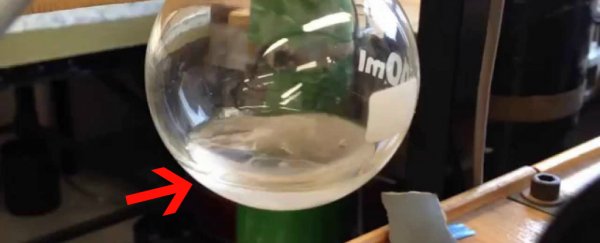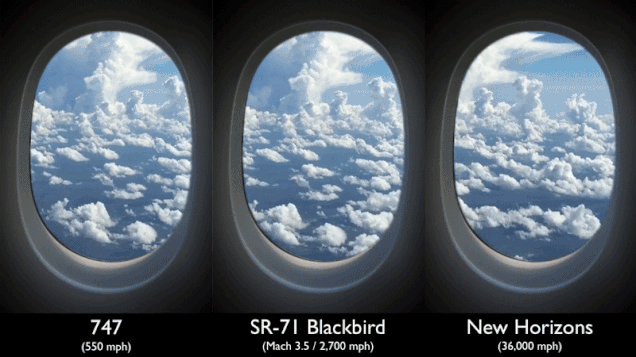We learn about some awesome science in high school - like Einstein's theory of relativity, the Periodic table, and DNA replication.
The knowledge we pick up there sets the foundations for all the other amazing things we go on to study. But science definitely doesn't end at high school, and it's once you take your learning to the next level that things get really interesting.
In no particular order, here are some mind-bendingly incredible facts that we didn't learn at high school, but wish we did. Because I certainly would have paid a whole lot more attention if my teacher had shared a few of these insights in class.
Side note: if you did learn about all of this and more at school, then you had a kick-ass teacher and you should probably tell them that.
1. Water can boil and freeze at the same time
Seriously, it's called the 'triple point', and it occurs when the temperature and pressure is just right for the three phases (gas, liquid, and solid) of a substance to coexist in thermodynamic equilibrium. This video shows cyclohexane in a vacuum.
2. Lasers can get trapped in a waterfall
Oh my gosh, yes. Not only is this an incredible example of total internal reflection, it also shows how fibre optic cables work to guide the flow of light.
3. We've got spacecraft hurtling towards the edge of our Solar System really, really fast
We all know rockets are fast, and space is big. But sometimes when we're talking about how long it takes for us to get to distant parts of the Solar System (eight months to get to Mars, are you kidding me?) it can feel like our spacecraft are just crawling along out there.
This gif shows just how wrong that idea is by comparing the speed of the New Horizons probe, which flew past Pluto last year, to a 747 and SR-71 Blackbird.
4. An egg looks like a crazy jellyfish underwater
A cracked egg on land might make a big mess, but 18 metres (60 feet) below the surface of the ocean, the pressure on the egg is 2.8 times atmospheric pressure, and it holds it all together like an invisible egg shell. True story.
5. You can prove Pythagoras' theorem with fluid
Not buying what your maths teacher is selling when they tell you a2 + b2 = c2? You can actually prove it with liquid.
6. This is what happens when a black hole swallows a star
As the star gets sucked up into the black hole, a huge jet of plasma is burped out, spanning hundreds of light-years. "When the star is ripped apart by the gravitational forces of the black hole, some part of the star's remains falls into the black hole, while the rest is ejected at high speeds," explains Johns Hopkins University researcher, Suvi Gezari.
7. You CAN see without your glasses
According to MinutePhysics, all you need to do is make a pinhole with your hand, which will help you focus the light coming into your retina. Sure, it won't give you 20/20 vision, but it's a good start if you've left your glasses at home.
8. This is how a face forms in the womb
Embryonic development is an incredibly complex process that scientists are still just beginning to understand. But one thing researchers have been able to map out is how the embryo folds to create the structures of the human face in the womb. We could watch this all day.
9. Popping your knuckles isn't necessarily bad for you
One researcher popped the knuckles of one hand for 60 years but not the other, and found no discernible difference in the amount of arthritis between the two of them at the end of his experiment.
Find out more in this video from Vox:
10. A single solar flare can release the equivalent energy of millions of 100-megaton atomic bombs
And they're happening all the time.
11. Cats always land on their feet, thanks to physics
As Smarter Every Day demonstrated with this awesome slow-mo footage, cats actually use the two halves of their bodies separately to ensure rapid rotation (don't try this at home).
Watch the full video here:
12. You'd be better off surviving a grenade on land rather than underwater
Those balloons? That's what would happen to your lungs if an explosion went off near you underwater.
13. If you spin a ball as you drop it, it flies
I mean, it really flies. It's thanks to the Magnus effect, which occurs when the air on the front side of a spinning object is going the same direction as its spin, which means it gets dragged along with the object and deflected back.
Meanwhile, the air on the other side of the ball is moving in the opposite direction, so the air flow separates.
Watch Veritasium explain it better than we ever could:
We could keep going… but the best part about science is that it discovers new things every day. Never stop learning.
BRB… going to go drop a feather and a bowling ball at the same time:
An earlier version of this post was originally published in October 2017.






